Form PF Reporting: SEC, CFTC Joint Final Rule
Expanded reporting requirements for investment advisers to private funds, including hedge funds

KPMG Regulatory Insights
- Expanding Private Fund Coverage: Continued increasing regulatory requirements to the private fund market (including hedge fund advisers) to increase transparency in terms of investment exposure, positions, and borrowing/financing arrangements.
- Stability/Systemic Risk Management: Form PF rules intended to fill “information gaps” that may help the SEC, CFTC and FSOC better understand and identify financial stability and systemic risks.
- Additional Regulatory Scrutiny: Expect enhanced private fund scrutiny of compliance to new rulemaking, insider trading/conflicts of interest, risk management/controls and risk governance.
__________________________________________________________________________________________________________________________________________________
February 2024
The Securities and Exchange Commission (SEC) and the Commodity Futures Trading Commission (CFTC), (together, Commissions), jointly adopt a final rule to amend Form PF (17 CFR 279.9) “largely as proposed”. The final rule expands the reporting requirements for certain SEC-registered investment advisers to private funds that are also registered with the CFTC as a commodity pool operator or commodity trading adviser. According to the Commissions, the adopted amendments aim to enhance the ability of the Financial Stability Oversight Council (FSOC) to monitor and assess systemic risk as well as “strengthen the effectiveness of the SEC's regulatory programs, including examinations, investigations, and investor protection efforts relating to private fund advisers.”
As adopted (and outlined below), changes to Form PF reporting are intended to:
- Enhance reporting by large hedge fund advisers on qualifying hedge funds
- Enhance reporting of basic information about advisers and the private funds they advise
- Enhance reporting concerning hedge funds
- Amend reporting for complex structures
- Eliminate aggregate reporting for large hedge fund advisers
The Commissions highlight the following key changes from the proposed rule based on comments received:
- Reporting Master-Feeder and Parallel Fund Structures: Instructions now specify how a feeder fund is required to treat its equity in the master fund for the purpose of determining its reporting threshold and responding to certain questions.
- Reporting Trading Vehicles: Advisers are required to identify trading vehicles in section 1b of Form PF and report on an aggregated basis for the reporting fund and all trading vehicles (whether fully owned by the reporting fund or partially owned). Advisers are also to specify whether the reporting fund holds assets, incurs leverage, or conducts trading or other activities through a trading vehicle.
- Definition of Digital Assets: The Commissions did not adopt the proposed definition of digital assets “at this time”.
Changes to Form PF reporting include:
1. Enhanced reporting by large hedge fund advisers on qualifying hedge funds. Impacts large hedge fund adviser reporting on “qualifying hedge funds” which are defined by the SEC as those with a net asset value of at least $500 million, including how large hedge fund adviser report:
- Investment exposures
- Borrowing and counterparty exposure
- Market factor effects
- Currency exposure
- Turnover
- Country and industry exposure
- Central clearing counterparty reporting
- Risk metrics
- Investment performance by strategy
- Portfolio liquidity, and financing and investor liquidity
2. Enhanced reporting on basic information about advisers and their private funds. Changes to Section 1 of Form PF aim to provide greater insight into private funds' operations and strategies, assist in identifying trends, improve comparability across advisers, and enhance data quality. This information will include:
- Identifying information
- Assets under management
- Withdrawal and redemption rights
- Gross asset value and net asset value
- Inflows and outflows
- Base currency
- Borrowings and types of creditors
- Fair value hierarchy
- Beneficial ownership
- Fund performance
3. Enhanced reporting concerning hedge funds: More detailed reporting of hedge fund investment strategies, counterparty exposures, and trading and clearing mechanisms employed by hedge funds will be required.
4. Amended reporting for complex structures. Advisers are generally required to separately report each component fund of a master-feeder arrangement and parallel fund structure. Furthermore, advisers will be required to identify trading vehicles utilized by the reporting funds and to report them on an aggregated basis.
5. Elimination of aggregate reporting for large hedge fund advisers. The Commissions removed the aggregate reporting requirement for large hedge fund advisers to focus on “more valuable information for systemic risk assessment purposes”.
_______
Digital Assets. As proposed, the Commissions adopted amendments to require advisers to hedge funds to report on the fund’s use of digital assets as an investment strategy. The Commissions also adopted an amendment to the term “cash and cash equivalents” that directs advisers to exclude digital assets when reporting cash and cash equivalents. The Commissions did not adopt the definition of digital assets included in the proposal (or any alternative definition “at this time”).
Compliance. The final amendments will become effective one year after publication in the Federal Register, and compliance will be required as of the same date.
Dive into our thinking:
Form PF Reporting: SEC, CFTC Joint Final Rule
Expanded reporting requirements for investment advisers to private funds, including hedge funds
Download PDFExplore more
Get the latest from KPMG Regulatory Insights
KPMG Regulatory Insights is the thought leader hub for timely insight on risk and regulatory developments.
Meet our team




